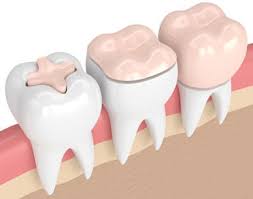This is a sponsored guest post.
In the word biomimetics, bio means life. Mimetics mean to mimic or imitate. The word itself means to use substances or materials closely associated with human substances and materials for the body to function normally.

For example, if a person’s tooth is decaying, a biomimetic dentist will use materials closely matching the dentin beneath the enamel, for instance, to return a tooth to normal function.
Mimicry enters the picture when the substances or materials begin to imitate the body’s function as if the material were its own. Teeth are sealed so bacteria can’t wreak havoc. Teeth will function properly with no outside stress. They’ll look perfectly normal as well.
When The Idea Began
Replacements for faulty body parts, scientists feel, began over 2,500 years ago. The common practice was to replace missing or decayed teeth with that of animals, mostly carved from the bones of oxen or the ivory from elephant tusks. However, history tells us that ancient Chinese medical men used carved bamboo as replacement teeth, and Egyptians used iron as replacements.
Fast forward to 1952, when an orthopedic surgeon named Branemark was experimenting with titanium alloy and rabbit legs. Fusing the titanium to the leg gave the surgeon the idea the same could be done with teeth. He experimented on it, gaining the knowledge that the titanium screw fused to the jawbone. A crown could be placed atop it for replacing a tooth.
Biomimetic Dentistry Today
Traditional dentistry meant grinding down a tooth or teeth to fit a bridge containing replacement teeth made of foreign materials. Decaying teeth were removed so dentures could be made. Broken or fractured teeth formerly had to be removed with a crown as a replacement.
This grinding and removal caused stress to the fundamental structure of the teeth. Foreign materials often do not perform well due to the adverse reaction of the rest of the jaw and teeth. Add to this the fact that bodily diseases such as Diabetes Mellitus cause bone loss with teeth coming loose, and you have the perfect setting for biomimetic dentistry solutions.
The development of materials used in biomimetic dentistry is ongoing and researched by scientists all over the world. Research shows that the materials are largely composed of calcium and ceramic derivatives used to form dentin and other tooth materials such as root filler.
These materials act like the body’s own materials. No stress will affect the teeth. Teeth can be rebuilt and will continue as before with their own movement, stronger and forming a beautiful smile.
Benefits Of Biomimetic Dentistry
The body can heal itself. Unfortunately, teeth aren’t like that, writes Dr. Marc Lazare – an expert in biomimetic dentistry. The above-described technologies basically mean that with biocompatible materials layered onto damaged teeth, dentists can help teeth heal naturally.
Strength
Much like 3D printing, biomimetic materials are layered onto the tooth. Layered items are much stronger than single items. This means that future damages don’t involve the whole structure and can be more easily and quickly repaired.
The structure is then sealed, preventing bacteria from entering the structure and causing further damage. Root canals are a thing of the past.
Time
A further benefit of biomimetic dentistry is the time factor. Formerly, a patient had to have the base work done and then return to be fitted for a crown or denture. This meant pain took longer to heal. Today, the work can be done in one day. It is time-intensive, though, but patients won’t be returning for further work, nor will the pain be a continuing factor.
Economics
One benefit of biomimetic dentistry is the financial aspect. Saving a damaged tooth using biocompatible materials is less expensive than using foreign materials. The tooth is stronger, it lasts longer, and if the damage is done to the restored tooth, repairs are less expensive.
Comfort
Dr. Marc Lazare is aware of the comfort factor in dentistry. Traditional dentistry is invasive and often leads to tooth sensitivity following a procedure. Biomimetic dentistry is minimally invasive, not painful, and leaves a strong tooth behind, not one that is sensitive. Patients feel more secure knowing this, thus they are not fearful of seeing the dentist. A patient at ease is desirable to both dentists and patients.
Aesthetics
Since our smile is the first thing people see and by which they judge us, it makes sense that everyone would like a blazing white smile.
Traditional dentistry uses veneers and color-coordinated materials to restore that white smile. Biomimetics matches more natural materials to the color of the existing smile, restoring patients’ confidence and satisfaction.
Who Would Benefit From Biomimetic Dentistry?
It’s easy to say that everyone would benefit from biomimetic dentistry, but the truth is that everyone would. Traditional dental fixes don’t last for long before another shock to the structure occurs. Breaks, cracks, fractures, and the resulting damages can now be repaired using more natural materials.
Those whose teeth are suffering structural damages caused by other bodily diseases would benefit most. The biocompatible materials won’t be affected much by these diseases. Patients can have confidence in the soundness of the structures. Not only that, but they can rest assured that leaks from dental materials won’t cause further havoc in the body.



